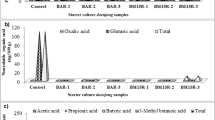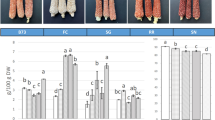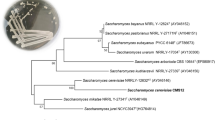Abstract
The United States continues to be the world's largest producer of the common mushroom Agaricus bisporus Lange. This solid-state fermentation is now one of the most challenging and technically demanding of all vegetable cultivations known to man. Currently, it is the only major process in biotechnology which successfully converts cellulosics into useful foods and byproducts. However, it is only recently that we are beginning to gain a better understanding of the distinct and complex microbial processes involved in mushroom cultivation.
This is a preview of subscription content, access via your institution
Access options
Subscribe to this journal
Receive 12 print issues and online access
$209.00 per year
only $17.42 per issue
Buy this article
- Purchase on Springer Link
- Instant access to full article PDF
Prices may be subject to local taxes which are calculated during checkout
Similar content being viewed by others
References
Hayes, W.A. and Wright, S.H. 1979. Edible mushrooms. p. 141–176 In: Economic Microbiology, A. H. Rose (ed.), Academic Press, New York.
USDA.1983. 1982–83 Mushroom production and value-up. Crop Reporting Board, U.S. Dept. of Agric., Washington, DC.
Wuest, P.J. 1983. Resources needed to farm the “champignon”. Mycol. 75: 341–350.
Kurtzman, R.H. 1979. Mushrooms: single cell protein from cellulose. p. 305–339 In: Annual Reports on Fermentation Processes. D. Perlman (ed.), Vol. 3, Academic Press, New York.
Hayes, W.A. and Nair, N.G. 1975. The cultivation of Agaricus bisporus and other edible mushrooms, p. 212–248 In: The Filamentous Fungi. J. E. Smith and D. R. Berry (eds.), Vol. 1. E. Arnold. London.
Hayes, W.A. 1974. Mushroom cultivation—prospects and developments. Proc. Bioc. 9: 21–24, 28.
Chang, S.T. 1980. Mushrooms as human food. Bioscience 30: 399–401.
Hayes, W.A. 1974. Microbiological activity in the casing layer and its relation to productivity and disease control. p. 27–48 In: The Casing Layer. W. A. Hayes (ed.), London.
Lambert, E.B. 1938. Principles and problems of mushroom culture. Bot. Rev. 4: 397–426.
Hatch, R.T. and Finger, S.M. 1964. Mushroom fermentation. p. 179–199. In: Microbial Technology, 2nd edition. H. J. Peppier and D. Perlman (eds.), Academic Press, New York.
Royse, J. and Schisler, L.C. 1980. Mushrooms: their consumption, production, and culture development. Interdis. Sci. Rev. 5: 324–332.
Block, S.S. 1964. Composting conversion of solid wastes for mushroom growing. Biotech. Bioeng. 6: 403–418.
Chang, S.T. 1980. Mushrooms from waste. Food Policy 5: 64–65.
Hardemare, G., Amid, J.M. and Dur and, R. 1972. Utilisation decomposts urbains en addition au compost de fumier de cheval dans la culture du champignon de couche. Mushr. Sci. 8: 59–65.
Tautorus, T.F. and Chalmers, W.T. 1984. Pilot plant production of single-cell protein utilizing Chaetomium olivaceum. Dev. Ind. Micb. 47: In press.
Kinrus, A. 1974. Techniques and methods in the U. S. mushroom industry. Mushr. Sci. 9: 165–173.
Sinden, J.W. and Mauser, E., 1953.The nature of the composting process and its relation to short composting. Mushr. Sci. 2: 123–130.
Muller, F.M. 1965. Some thoughts about composting. Mushr. Sci. 6: 213–222.
Burrows, S.S. 1951. The chemistry of mushroom composts. J. Sci. Food Agric. 2: 403–410.
Crawford, J.H. 1983. Composting of agricultural wastes— A review. Proc. Bioc. 18: 14–18.
Gerrits, J.P.G., Bels-Koning, J.C. and Muller, F.M. 1965. Changes in compost constituents during composting, pasteurization, and cropping. Mushr. Sci. 6: 225–243.
Gray, K.R., Sherman, K. and Biddlestone, A.J. 1971. A review of composting— part I. Proc. Bioc. 6: 32–36.
Mattingly, G.E.G. 1952. Changes in the distribution of nitrogen during the composting of straw. Nature 169: 75–76.
Schisler, L.C. 1980. Composting. Mushr. News 28: 5–13.
Schobinger, U. 1958. Chemische untcrsuchunger uber die umwand-lung von weizenstrohlignin im laufe der verrottung. Dissertation. E. T. H., Zurich.
Waksman, S.A. and Cordon, T.C. 1939. Thermophilic decomposition of plant residues in composts by pure and mixed cultures of microorganisms. Soil Sci. 47: 217–224.
Waksman, S.A., Cordon, T.C. and Hulpoi, E.N. 1939. Influence of temperature upon the microbiological population and decomposition processes in composts of stable manure. Soil Sci. 47: 83–112.
Waksman, S.A. and lycr, K. R. M. 1932. Contributions to our knowledge of the chemical nature and origin of humus: I. On the synthesis of the “humus nucleus”. Soil Sci. 34: 43–70.
Waksman, S.A. and lyer, K.R.M. 1932. Contributions to our knowledge of the chemical nature and origin of humus: II. The influence of'synthesized' humus compounds and of “natural humus” upon soil microbiological processes. Soil Sci. 34: 71–79.
Waksman, S.A. and McGrath, J.M. 1931. Preliminary study of chemical processes involved in the decomposition of manure by Agaricus campestris. Amer. J. Bot. 18: 573–581.
Waksman, S.A. and Nissen, W. 1931. Lignin as a nutrient for the cultivated mushroom, Agaricus campestris. Science 74: 271–272.
Waksman, S.A. and Nissen, W. 1932. On the nutrition of the cultivated mushroom and the chemical changes brought about by this organism in the manure compost. Amer. J. Bot. 19: 514–537.
Fletcher, J.T. 1979. Bacteria and mushrooms. Mushr. J. 82: 451–457.
Waksman, S.A., Umbreit, W.W. and Cordon, T.C. 1939. Thermophilic actinomycetes and fungi in soils and in composts. Soil Sci. 47: 37–60.
Hayes, W.A. 1969. Microbiological changes in composting wheat straw/horse manure mixtures. Mushr. Sci. 7: 173–186.
Hayes, W.A. 1977. Mushroom nutrition and the role of microorganisms in composting, p. 1–20 In: Composting. W. A. Hayes (ed), London.
Imbernon, M. and Leplae, M. 1972. Microbiologie des substrates destines a la culture du champignon de couche. Mushr. Sci. 8: 363–370.
Oliver, J.M. and Guillaumes, J. 1976. Effect antagoniste exerce in vitro par le mycelium de Psalliota Irispora Lange vis-a-vis de differentes especes fongiques et bacteriennes. Ann. Phyto. 8: 213–231.
Stanek, M. 1972. Microorganisms inhabiting mushroom compost during fermentation. Mushr. Sci. 8: 797–811.
Eastwood, D.J. 1952. The fungus flora of composts. Trans. Brit. Mycol. Soc. 35: 215–220.
Fergus, C.L. 1964. Thermophilic and therrnotolerant molds and actinomycetes of mushroom compost during peak-heating. Mycol. 56: 267–284.
Fermor, T.R., Smith, J.F. and Spencer, D.M. 1979. The microflora of experimental mushroom compost. J. Hort. Sci. 54: 137–147.
Fotdyce, C. 1970. Relative numbers of certain microbial groups present in compost used for mushroom (Agaricus bisporus) propagation. Appl. Micb. 20: 196–199.
Laborde, J., Delmas, J. and d'Hardemare 1969. Note preliminaire sur quelques aspects de l'équilibre microbiologique des composts. Mushr. Sci. 7: 187–203.
Renoux-Blondeau, H. 1959. Etude de certains actinomycetes se develloppart au cours de la pasteurization dui fumir. Leur action sur le developpement ulteriur du champignon de couche. Mushr. Sci. 4: 153–175.
Stanek, M. 1967. Microorganisms colonizing mushroom compost during fermentation. Mykol. sbor. 4: 57–63.
Stanek, M. and Rysava-Zatecka, J. 1967. Effect of aerobic cellulose decomposing microorganisms on the growth of mycelium of cultivated mushroom. Pestovani zampionu 4: 8.
Yung-Chang, W. and Hudson, H.J. 1967. The fungi of wheat straw compost. I. Ecological studies. Trans. Brit. Mycol. Soc. 50: 646–666.
Eddy, B.P. and Jacobs, L. 1976. Mushroom compost as a source of food for Agaricus bisporus. Mushr. J. 38: 56–5967.
Townsley, P.M. 1974. Pure cultural industrial fermentation in the production of mushrooms. Can. Inst. Food Sci. Tech. J. 7: 254–255.
Stanek, M. 1968. Die wirkung der zellulosezersetzenden mikroorganismen auf das wachstum des champignon. Mushr. Sci. 7: 161–172.
Till, O. 1962. Champignonkultur auf steriliziertem nahrsubstrat und die wiederverwendung von abgetragenem kompost. Mushr. Sci. 5: 127–133.
Huhnke, W. and Von Sengbush, R. 1968. Champignonabau auf nicht kompostiertem nä hrsubstrat. Mushr. Sci. 7: 405–409.
Laborde, J. 1980. Rapid substrate making. Mushr. J. 94: 349–355.
Laborde, J. and Delmas, J. 1969. Preparation express des substrats. Bull. FNSACC. 10: 2093–2109.
Laborde, J., Delmas, J., Lamau, J.L. and Berthaud, J. 1972. La preparation express des substrates (P.E.S.) pour la culture du champignon de couche. Mushr. Sci. 8: 675–706.
Smith, J.F. 1974. Selective substrates and rapid methods of preparation. Mushr. J. 23: 424–426.
Smith, J.F. 1981. Save it: advantages of short-duration composts. Mushr. J. 106: 334–337.
Smith, J.F. 1983. The formulation of mixtures suitable for economic short duration mushroom composts. Scientia Hort. 19: 65–78.
Smith, J.F. and Spencer, D.M. 1976. Rapid preparation of composts suitable for the production of the cultivated mushroom. Scientia Hort. 5: 23–31.
Smith, J.F. and Spencer, D.M. 1977. The use of high energy carbon sources in rapidly prepared mushroom compost. Scientia Hort. 7: 197–205.
Hayes, W.A. and R and le, P.E. 1969. Use of molasses as an ingredient of wheat straw mixtures used for the Preparation of mushroom composts. Report Glasshouse Crops Res. Inst. p. 142–147.
Hayes, W.A. and R and le, P.E. 1969. The use of water soluble carbohydrates and methyl bromide in the Preparation of mushroom compost. MGA Bull. 28: 81–97.
Pope, S., Knaust, H. and Knaust, K. 1962. Production of compost by thermophilic fungi. Mushr. Sci. 5: 123–126.
Tautorus, T.E. and Townsley, P.M. 1983. Biological control of olive green mold in Agaricus bisporus cultivation. Appl. Env. Micb. 45: 511–515.
Burden, O.J. and Peterson, R.A. 1972. Cultivating mushrooms. Queensl and Agric.J. 98: 63, 141.
Smith, J. 1969. Commercial mushroom production. Proc. Bioc. 4: 43–4652.
Bels-Koning, H.C., Gerrits, J.P.G. and Va and rager, M.H. 1962. Some fungi appearing towards the end of composting. Mushr. Sci. 5: 170–179.
Kleyn, J.G. and Wetzler, T.F. 1981. The microbiology of spent mushroom compost and its dust. Can. J. Micb. 27: 748–753.
Mattoni, R.H.T., Acker, D., Marx, P.F.B., Blank, B.B. and Nishda, J. 1972. Experiments on aflatoxin translocation to the commercial mushroom. Mushr. Sci. 8: 315–319.
Tendler, M.D. and Burkholder, P.R. 1961. Studies on the thermophilic actinomycetes. I. Methods of cultivation. Appl. Micb. 9: 394–399.
Ross, R.C. and Harris, P.J. 1983. An investigation into the selective Nature of mushroom compost. Scientia Hort. 19: 55–64.
Persiel, F. 1968. The effect of bacteria on the mycelial growth of Agaricus bisporus (Lge) Sing. Garten. 33: 57–66.
Vedder, P.J.C. 1978. Modern mushroom growing. Educabock, B. V. Culemborg, The Netherl and s.
Stanek, M. 1974. Bacteria associated with mushroom mycelium Agaricus bisporus (Lge) Sing, in hyphosphere. Mushr. Sci. 9: 197–201.
Eger, G. 1962. Einfluchtiges stoffwechsel product des kulturcham-pignons, Agaricus (Psalliota) bisporus (Lge) Sing, mit antibiotisher wirkung. Natur. Schaften 49: 261.
Eger, G. 1972. Experiments and comments on the action of bacteria on sporophore initiation in Agaricus bisporus . Mushr. Sci. 8: 719–725.
Fergus, C.L. 1978. The fungus flora of compost during mycelium colonization by the cultivated mushroom Agaricus brunnescens. Mycol. 70: 636–644.
Hayes, W.A. 1980. Solid state fermentation and the cultivation of edible fungi, p. 175–202. In: Fungal Biotechnology. J. E. Smith, D. R. Berry and B. Kristiansen (eds), Academic Press, New York.
Couvy, J. 1972. Etude de 1'induction de la fructification chez Agaricus bisporus (Lange) Sing (Psalliota hortensis Cke): action du glucose. Comptes rendus hebdemadaire des séances de 1'Académic des Sciences 274: 2475–2477.
Eger, G. 1961. Untersuchungen iiber die funktion der deckschicht vei der fruchtorperbildung des kulturchampignons Psalliota bispora Lg. Archiv. fur Mikrob. 39: 313–334.
Hayes, W.A. 1972. Nutritional factors in relation to mushroom production. Mushr. Sci. 8: 663–674.
Hayes, W.A., R and le, P.E. and Last, F.T. 1969. The nature of the microbial stimulus affecting sporophore formation in Agaricus bisporus (Lge) Sing. Ann. Appl. Biol. 64: 177–187.
Curto, S. and Favelli, F. 1972. Stimulative effects of certain microorganisms (bacteria, yeasts, microalgae) upon fruitbody formation of Agaricus bisporus (Lge) Sing. Mushr. Sci. 8: 67–74.
Hume, D.P. and Hayes, W. A. 1972. The production of fruit-body in Agaricus bisporus (Lange) Sing, on agar media. Mushr. Sci. 8: 527–532.
O'Donoghue, D. 1965. Relationship between some compost factors and their effects on the yield of Agaricus. Mushr. Sci. 6: 245.
Park, J.Y. and Agnihorti, V.P. 1969. Bacterial metabolites trigger sporophore formation in Agaricus bisporus . Nature 222: 984.
Hayes, W.A. and Nair, N.G. 1974. Effects of volatile metabolic byproducts of mushroom mycelium on the ecology of the casing layer. Mushr. Sci. 9: 259–268.
Wood, D.A. 1976. Primordium formation in axenic cultures of Agaricus bisporus (Lge) Sing. J. Gen. Micb. 95: 313–323.
Stoller, B.B. 1975. Induction of fruiting in the casing layer. Quinones or CO2? Mushr. News 10: 22.
Ingratta, F. 1980. Where are we going? (In mushroom growing). Mushr. J. 85: 47–51.
Chang, S.T. and Hayes, W.A. 1978. The biology and cultivation of edible mushrooms. Academic Press, New York.
Flegg, P.B. and Smith, J.F. 1982. Effect of spawn strain and available substrate on the relative yield of mushrooms in successive flushes. Scientia Hort. 17: 217–222.
Cooke, D. and Flegg, P.B. 1965. The effect of stage of maturity at picking on the flushing of crop of the cultivated mushroom. J. Hort. Sci. 40: 207–212.
Langar, P.N., Sehgal, J.P., Rana, V.K., Singh, H.S. and Garcha, H.S. 1982. Utilization of Agaricus bisporus— cultivated spent wheat straw in the ruminant diets. Ind. J. Animal Sci. 52: 634–637.
Wilson, L.L., Turner, M.L., Weiss, M.J. and Harpster, H.W. 1983. Mushroom industry wastes studied as livestock feeds. Sci. Agric. 30: 7.
Bowden, J.D. and Alien, P.G. 1976. Cultural studies on mushrooms 1974–76. Exp. Hort. 30: 66–75.
Nair, N.G. 1976. Studies on recycling spent compost for mushroom cultivation. Aust. J. Agric. Res. 27: 857–865.
Kleyn, J.G., Johnson, W.M. and Wetzler, T.F. 1981. Microbial aerosols and actinomycetes in etiological considerations of mushroom worker's lungs. Appl. Env. Micb. 41: 1454–1460.
Lockey, S.D. 1974. Mushroom worker's pneumonitis. Ann. Allergy 33: 282–288.
Esser, K. 1977. Concerted breeding in fungi and its biotechnological application. Endeavour 1: 143–148.
Huhnke, W. 1970. Modern mushroom growing. Sci. J. 6: 62–66.
Kurtzman, R.H. 1982. Mushroom growing medium. patent ♯4,333,757. U.S.A.
Tautorus, T.E. and Townsley, P.M. 1984. Analysis of an effective antibiotic (chaetomacin) isolated from a thermophilic Bacillus sp against olive green mold. Appl. Env. Micb. 47: 775–779.
Author information
Authors and Affiliations
Rights and permissions
About this article
Cite this article
Tautorus, T., Townsley, P. Biotechnology in Commercial Mushroom Fermentation. Nat Biotechnol 2, 696–701 (1984). https://doi.org/10.1038/nbt0884-696
Issue Date:
DOI: https://doi.org/10.1038/nbt0884-696



